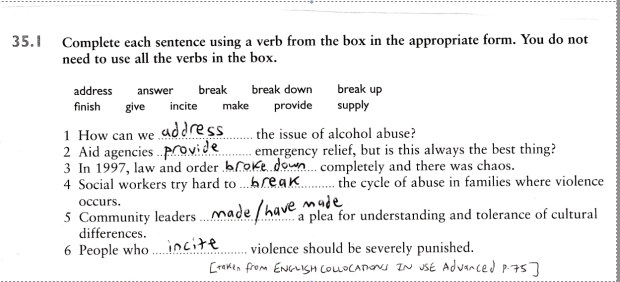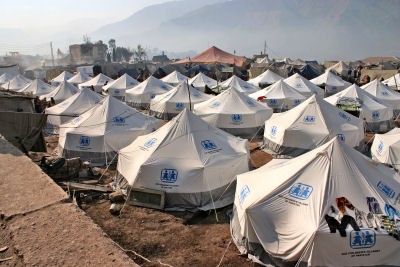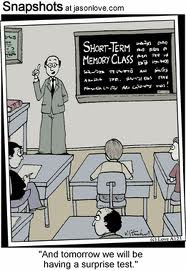In the two previous posts in this little mini-series, I have talked firstly about how I might tackle any given piece of vocabulary-based / lexical self-study material that you bring into class in terms of what I’d do, say, ask and write whilst checking the answers, and then in the second post I looked at ways we might get students to connect more personally to the language that emerges from working with an exercise in this kind of way – and what we might then with the output they produce.
In this post, I intend to just briefly outline three other ways you could get students to do more with what’s there on the page – or, as is more likely to be the case in this instance, on the photocopied handout (just make sure you’re all aware of the 5% rule and that your institution is signed up with the CLA!). These are all things Andrew Walkley and I will be exploring and discussing in more detail in a methodology book we’re slowly plugging away at, so i don’t want to give away the whole secret recipe, but a taster never hurt anyone now, did it?
In case you’ve forgotten what we’re talking about here, I’ll insert the piece of material i selected to base things on:
Now, the first thing you can get do students to do is to develop what’s there either horizontally or vertically. All too often with sentences in coursebooks or exercises, students tend not to see them as anything other than dead objects to be completed, checked and then discarded or progressed on from, so anything we can do to help them engage further with what’s there can only be a good thing. The idea of getting students to think about how the examples that are there could be developed in discourse terms is one way of doing this. It also gives the teacher the chance to help students both grammaticalise and lexicalise their ideas better and deals with student output and ideas in a holistic way.
By horizontal development, I mean thinking about what might be said by the same speaker / writer immediately afterwards – or possibly even immediately before. Vertical development is more to do with how a dialogue or conversation featuring the example might then progress, how another person might respond to what’s been said.
In classroom terms, all I’d do, once I’d checked the answers and worked the language that was there, is simply tell the students to look at the six sentences again and, with a partner, decide (and write – this makes it easier for the teacher to see what students have come up with, which in turn makes it easier to build up towards feedback) what was said or written immediately after – or maybe before each sentence. It could be what was written / said by the same person or by another person. I might go through one with the whole class to model the task, so I’d ask, for instance: OK, with number 1, do you think it’s more likely to be the same person or a different person who speaks next? The same? yeah, me too. Why? Right. It sounds like a speech or something, doesn’t it? Or maybe an essay putting forward a particular argument. So what’s the next line, do you think? yeah, probably one idea about what we can actually do to address the issue of alcohol abuse. For instance? Yeah, raise taxes on alcohol. So it might be something like this: Well, firstly, the tax on alcohol could be increased. I’d make it passive here because the raising of the taxes isn’t done by the speaker, but by someone else, like a government person. Plus, it puts emphasis on the tax increase more. OK then, so like this. For all six sentences, what’s said afterwards – or maybe before.
As students worked together, coming up with ideas, I’d then go round, check what they were coming up with, help out, correct, question, comment and so on. As ever, I’d also be looking for ideas I could rework on the board to base some kind of feedback on. As I came across ideas I liked, I’d write things up on the board, with gaps left in, to come back to once the majority of pairs had more or less finished. Of course, if I failed to see anything worth picking up on, I’d simply invent stuff based on what I think might be said next – or before! In the end, the board might have things like this on it:
Less developed countries end up being d……………… on richer ones and never have the chance to develop their own in……………….. for dealing with these kinds of things. Shops were looted, cars were stolen, it was awful! It took the police days to re……………. c…………… of some the worst-affected areas. In the w……….. of these latest attacks, community leaders have made a plea for calm.I’d then simply paraphrase the missing words (dependent, infrastructure, regain control, wake) in order to elicit them. For instance, I’d say something like: OK, so some of you were saying that one of the problems with aid agencies always providing emergency relief is that it kind of makes countries lazy; they feel they can always rely on other countries helping them, so they don’t develop all the systems needed to tackle disasters. They come to rely on other countries, they end up being MM-MM-MM on them. Right. Dependent on them.
Let’s move on. Another thing teachers can do to encourage some kind of deeper engagement with content is what we’ve dubbed read, remember, cover, say and check.
As I said earlier, all too often for students completion of an exercise becomes the end goal and once the answers have been checked, they don’t always do enough to pay attention to – and attempt to learn – the language contained in the actual exercises. We can counter this by telling students to read the sentences again and to try and remember as much as they can. Then put students in pairs. All the A students should close their books (or turn their handouts over!), while the Bs keep their open. Student A then says each of the sentences in the exercise as accurately as they can. After each attempt, B either corrects or else says it was fine. As teacher, you could model the task by closing your own copy of the coursebook and saying what you remember of the first sentences – and then checking your answer! It always helps if you get it right, but not 100% right, so the students see your own humanity!
There are simple twists you can make to this exercise – and things you can encourage students to do at home as self-study. For instance, you could ask students to read, remember and then write individually what they remember. They could then compare with a partner, see if they can agree a final version and then check by opening their books. They could also do basically the same thing, but instead of writing, simply say what they remember and then check.
One final thing we can do to encourage students to pay more attention to the language and to notice how things work in English is two-way translation. Now, I’ve written before – and at some length – about translation and its many uses, but I feel it’s still a very under-used and under-appreciated technique / approach.
When students have finished an exercise, either tell them to translate all of it into their own first language or else select a few sentences to be translated. If you teach monolingual groups and speak the students’ L1, you can put students into pairs and tell them to decide on the best translation and then check ideas with the whole class. In multilingual classes, you may still be able to put groups of students who share the same L1 together to help each other. Even if you don’t speak your students’ L1, they’ll generally be able to translate so long as they understand the sentences. Tell students to ask you if there’s anything they are unsure of the meaning of.
Next, either collect the translations or tell students to keep the translations somewhere safe. Tell them you will return to them at some point later. In the next lesson or at some other later date, tell students to look back at their translations and – without looking at the English sentences they originally translated from – to write what they think the correct English is. Tell them to compare their translations in pairs and to discuss any differences. Let students compare their translations with the English originals and then discuss why any differences might have occurred. Ask if they can now see any differences in the patterns between the two languages.
Right, that seems like plenty for now.
Hope it’s given some of you a few more ideas on how to get more from less.




This is brillant stuff Hugh. I’ve tried these lexical methods out in class (lexical priming/ambient language) and they work fantastically well.
Just two questions though: is it possible to do this with lower levels such as pre-int or elementary? And secondly, what’s the best way to go about generating ambient co-text for priming? Sometimes it can be hard to come up with lexicalized co-text on your own, so would you have any tips on how to develop this useful skill?
Hi again Patrick –
Glad this all proved useful for you!
It’s served its purpose, then.
In terms of level, I’d say yes of course it can be done at lower levels – and even with basically complete beginners.
Obviously, the input changes (and you might want to go for slightly less too, as there’s less you can rely on them knowing already and can thus attempt to recycle / revisit) and the questions you’d ask would be much easier, but as the material you’d be using would be pitched at this level, in a sense that would dictate what you then ask / add. And students can still attempt personalisation or adding horizontally or whatever. They’d obviously not be able to do it anywhere near as well as higher level students, but they could still attempt it and you as a teacher could still help them say what they were trying to say better. Often at this level, that simply means taking basic strings of nouns and maybe a few basic verbs and grammaticalising them, all of which gives students repeat exposure to the core structures they’ll need time and time again.
When you ask about co-text, for what? For words that you’re teaching in any given exercise?
If that’s what you mean, then I think you just need to consider what’s usually done with those words.
When might they be used? What might be said before or after they’re used? And so on.
We used to do something on this as part of our interviews for CELTA courses.
We’d ask potential trainees what examples they’d give to a student who asked them about the phrasal verb GO UP.
Interestingly, most simply thought of the basic meaning in a very literal sense and would offer things like BALLOONS GO UP or I GO UP THE STAIRS.
It is, of course, true that balloons do go up and that people go up stairs, but neither of these are things you’d tell someone!
Far better examples were things like: UNEMPLOYMENT HAS GONE A HELL OF A LOT OVER THE LAST FEW MONTHS / PRICES HAVE GONE UP A LOT SINCE THE START OF THE YEAR and so on.
The co-text here is the time expressions used with the present perfect examples.
Does that answer the question?
If not and if I’m barking up the wrong tree, feel free to clarify what you meant and I’ll try again!
Hi Hugh,
The new posts have made for interesting reading – thanks. I was wondering if you give your students time to write down all the sentences you board? It seems a waste of a lot of new, relevant language if students don’t record it. What do you think?
Thanks,
Dan
Hi Dan –
Thanks for reading and for taking the time to comment.
I do, of course, leave time for students to write – and I’ve noticed that increasingly plenty also take photos.
My gut feeling is that it must be better to actually copy the language and to write, but some students have script issues and write very slowly (which to me seems more of a reason to get more practice in, but there’s only so many times you can tell them that!) and I guess don’t want to be shown up so snap away instead. I guess so long as they thjen still look at what they’ve photographed and do something with it, that’s fine.
Not having an IWB that stores this stuff automatically, I also take photos and use these as the basis both of subsequent explicit revision, but also as a way of reminding myself what language I might expect students to know when I’m choosing things to gap in future. I will try to write something on this soon.
I think that what this kind of boardwork actually offers students, by the way, is invaluable: it’s a mediated version of the language that appears in the coursebook. It’s what happens when the teacher and these students interact with that (and of course changes every time I teach the book, depending on what comes back from students, which keeps life interesting) and because it’s rooted in students’ own ideas and output, it perhaps has more reality and emotional validity for them as well, and thus may well be more memorable.
[…] a member of my PLN tweeted part 2 of the series (as linked). Of course I then also read part 1 (and part 3 when it later came out!) Bursting with helpful ideas, these posts really got me thinking and indeed […]
Hi Hugh,
Thanks for much for sharing the activities in these three posts. I missed them the first time round, but found them thanks to Lizzie Pinard’s pick of 2013.
It’s great to see so many ways to use a single activity – I wish I’d seen it when I was still working in the UK as I think it would have been particularly useful for my students then. There are a lot of ideas I’ll take into the classroom now, but I think it’s more difficult to dedicate so much time to a single set of vocabulary when you only see the students for 90 minutes a week. I always try to do one or two extension activities (or ‘memory stages’), but at some point I have to trust the students to take ownership of the language outside the classroom, even though I know that often doesn’t happen.
In terms of your writing style, it’s very useful to ‘hear’ what you would actually say to the students. When reading posts like this, I often wonder how the activities are actually presented to the students, and your ‘speech’ transcriptions make it very clear.
Thank you!
Sandy
Hi Sandy –
Thanks for taking the time to read and to comment.
It was very kind of Lizzie Pinard to mention me, and great if it brought a few more folk to these posts.
They’re very much straight from the classroom for me, so nice to know they’ve been enjoyed and have proved useful.
I do take your point about not always having as much time as maybe you’d like to exploit particular items of language, and I certainly wasn’t suggesting you do all of the stuff mentioned in these posts with each and every exercise. Obviously, you have to tailor things to time and the like. But I do believe quite strongly that it’s always better to do a bit more with a bit less than to always be moving on to the next thing before you’ve really fully taught what’s there on the page in any kind of full and meaningful way.
I also hear you loud and clear on needing to trust students to do some of the memory work outside of class, despite knowing that all to often they just won’t. teachers do need to be responsible for recycling and revising language, but we can’t do everything. I increasingly feel that a fairly key part of our role is actually spending time in class making it clearer in class how students can best use their time outside of class, on the understanding that they don’t have much and that they often have weird and poor self-study methods. Inculcating in them decent habits and frames of mind is an ongoing war of attrition, but a crucial one to wage.
Oh, and finally, glad the speech transcripts worked for you. I too often feel frustrated when I don’t really get exactly how a teacher would implement an idea in a classroom, and like to see extracts of real teaching, so this was my way of trying to tackle that issue a bit.
Thanks again for the interest.
Best
Hugh
[…] back to Hugh’s recent blog posts about exploiting lexical self-study material (part one, two, three). It is important to remind ourselves that ultimately we are language teachers, and language should […]